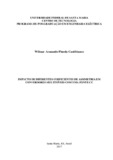| dc.creator | Castiblanco, Wilmar Armando Pineda | |
| dc.date.accessioned | 2021-07-15T18:49:26Z | |
| dc.date.available | 2021-07-15T18:49:26Z | |
| dc.date.issued | 2017-03-03 | |
| dc.identifier.uri | http://repositorio.ufsm.br/handle/1/21509 | |
| dc.description.abstract | Multilevel converters operating with single dc source represent an interesting and
simple solution, since only an isolated voltage source is required, even in applications with
active power transfer. In this way, the converter analyzed in this dissertation is composed of
the three-phase three-level main converter with neutral point clamped (NPC) powered by an
isolate voltage source. In addition, single-phase full-bridge (FB) auxiliary cells, supplied by
floating capacitors, are connected in series at each stage to increase the number of synthesized
levels. Different asymmetric coefficients between voltages on the main cells and the auxiliary
cells in series are exploited to synthesized waveforms with lower harmonic content and
reduce the stress on the auxiliary cells. Also, the limitations imposed by the modulation
strategy are considered, in which the main high-voltage converter operate with the
fundamental frequency of the reference ac voltage, the impact of these limitations on the
operation of the low-voltage auxiliary cells, which operate with pulsed-width modulation and
should not process active power is evaluated. As a result, over-modulation regions are
revealed in the auxiliary cells operation from the energy error between the reference signals
and the maximum signal that can be synthesized by the multilevel converter. In this way, for a
high asymmetric coefficient, the choice of an over-modulation region with minimal error
signal energy reduces the harmonic distortion on the line-to-line voltages but also with the
benefic, that the auxiliary cells will exposed to lower blocking voltages. Finally, results for
single dc source converter applied to the input rectifier stage the speed drive system and
operating with high asymmetric coefficient in a region with minimal energy error signal are
included. | eng |
| dc.description.sponsorship | Coordenação de Aperfeiçoamento de Pessoal de Nível Superior - CAPES | por |
| dc.language | por | por |
| dc.publisher | Universidade Federal de Santa Maria | por |
| dc.rights | Attribution-NonCommercial-NoDerivatives 4.0 International | * |
| dc.rights.uri | http://creativecommons.org/licenses/by-nc-nd/4.0/ | * |
| dc.subject | Conversores multiníveis assimétricos | por |
| dc.subject | Conversores multiníveis híbridos | por |
| dc.subject | Única fonte CC | por |
| dc.subject | Asymmetric multilevel converter | eng |
| dc.subject | Hybrid multilevel converter | eng |
| dc.subject | Single DC source | eng |
| dc.title | Impacto de diferentes coeficientes de assimetria em conversores multiníveis com uma fonte CC | por |
| dc.title.alternative | Impact of different assimetry coeficients on single DC source multilevel converters | eng |
| dc.type | Dissertação | por |
| dc.description.resumo | Conversores multiníveis com uma única fonte de tensão contínua representam uma
solução interessante em termos de simplicidade, pois somente uma fonte de tensão isolada é
necessária, mesmo em aplicações com transferência de potência ativa. Desta forma, o
conversor estudado nesta dissertação de mestrado é composto por uma célula principal três
níveis trifásica do tipo ponto neutro grampeado (Neutral Point Clamped – NPC) alimentado
por uma fonte de tensão isolada. Além disso, células auxiliares monofásicas, alimentadas por
capacitores flutuantes, são conectadas em série em cada fase para aumentar o número de
níveis sintetizados. Diferentes coeficientes de assimetria entre os valores das tensões do
barramento CC da célula principal e das células auxiliares em série são explorados para
sintetizar formas de onda com menor conteúdo harmônico e reduzir os níveis de tensão das
células auxiliares. Também são consideradas as limitações impostas pela estratégia de
modulação, em que a célula principal de alta tensão opera na frequência fundamental da
tensão CA de referência, e é avaliado o impacto dessas limitações na operação das células
auxiliares de menor tensão, que operam com modulação por largura de pulso e não devem
processar potência ativa. Como resultado, regiões de sobremodulação são reveladas na
operação das células auxiliares a partir da energia do erro entre o sinal de referência e o
máximo sinal que pode ser sintetizado pelo conversor. Assim, para um coeficiente de
assimetria elevado, a escolha de uma região com mínima energia do sinal de erro em
sobremodulação permite reduzir a distorção harmônica das tensões de linha, mas também com
o benefício de que as células auxiliares estarão expostas à menores tensões de bloqueio.
Finalmente, resultados do conversor multinível como uma fonte CC aplicado ao estágio
retificador de entrada de um sistema de acionamento de velocidade variável são incluídos,
operando com um coeficiente de assimetria elevado em uma região com mínima energia do
sinal de erro. | por |
| dc.contributor.advisor1 | Rech, Cassiano | |
| dc.contributor.advisor1Lattes | http://lattes.cnpq.br/9375639768929991 | por |
| dc.contributor.referee1 | Batschauer, Alessandro | |
| dc.contributor.referee2 | Carnielutti, Fernanda de Morais | |
| dc.creator.Lattes | http://lattes.cnpq.br/7540879877588308 | por |
| dc.publisher.country | Brasil | por |
| dc.publisher.department | Engenharia Elétrica | por |
| dc.publisher.initials | UFSM | por |
| dc.publisher.program | Programa de Pós-Graduação em Engenharia Elétrica | por |
| dc.subject.cnpq | CNPQ::ENGENHARIAS::ENGENHARIA ELETRICA | por |
| dc.publisher.unidade | Centro de Tecnologia | por |



